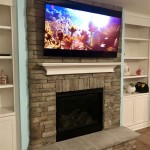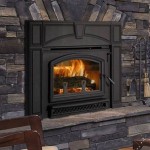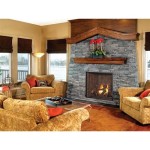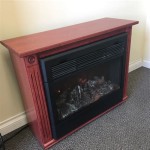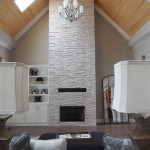Painting Fireplace Whitewash: A Comprehensive Guide
Whitewashing a fireplace is a cost-effective and aesthetically pleasing way to transform a dated or unappealing brick or stone hearth into a bright, modern focal point. The technique involves diluting paint, typically white or off-white, with water to create a semi-transparent finish that allows the texture of the brick or stone to remain visible. This guide provides a detailed overview of the whitewashing process, encompassing preparation, application, and essential considerations for achieving a successful and durable result.
Before embarking on the whitewashing project, a thorough assessment of the existing fireplace is crucial. The condition of the brick or stone, the presence of any existing paint or sealant, and the overall style of the room will influence the materials chosen and the application technique employed. Proper preparation is the bedrock of a long-lasting and visually appealing whitewashed fireplace.
Preparing the Fireplace for Whitewashing
The foundational step for a successful whitewashing project is meticulous cleaning of the fireplace. Over time, fireplaces accumulate soot, dust, and grime, which can impede paint adhesion and compromise the final finish. Begin by thoroughly sweeping or vacuuming the entire fireplace surface, including the firebox opening and any surrounding hearth. A stiff-bristled brush can be used to dislodge stubborn debris.
Following the initial dry cleaning, a more intensive cleaning is necessary. A solution of trisodium phosphate (TSP) or a specialized masonry cleaner should be applied to the brick or stone surface according to the manufacturer's instructions. TSP is a powerful degreaser and cleaner that effectively removes soot and other residues. Ensure adequate ventilation is present when using TSP, and wear appropriate protective gear, including gloves and eye protection. After applying the cleaning solution, scrub the fireplace using a scrub brush and rinse thoroughly with clean water. Allow the fireplace to dry completely before proceeding with the next steps.
If the fireplace has been previously painted or sealed, removal of the existing coating may be necessary. The necessity of removal depends on the condition of the existing paint or sealant. If the coating is peeling, chipping, or otherwise compromised, it must be removed to ensure proper adhesion of the whitewash. Various methods can be employed for paint removal, including chemical strippers, heat guns, and mechanical abrasion. Chemical strippers are effective but require careful handling and proper ventilation. Heat guns can soften the paint, allowing it to be scraped away, but caution must be exercised to avoid damaging the underlying brick or stone. Mechanical abrasion, such as sanding or wire brushing, can remove paint but may also alter the texture of the fireplace. Select the removal method that is best suited for the type of coating and the condition of the fireplace, always prioritizing safety and minimizing damage to the underlying material.
Once the fireplace is clean and any existing coatings have been removed, inspect the surface for cracks or other damage. Small cracks can be filled with a masonry patching compound. Larger cracks may require more extensive repairs, such as repointing the mortar joints. Addressing these issues before whitewashing will ensure a structurally sound and aesthetically pleasing finish. Allow the patching compound or mortar to cure completely according to the manufacturer's instructions before proceeding.
Finally, protect the surrounding area from paint splatters. Use painter's tape to mask off the walls, floors, and any other surfaces that you do not want to be whitewashed. Drop cloths or plastic sheeting should be used to cover the floor and furniture. Proper preparation will save time and effort in the long run by preventing unwanted paint from getting on surfaces.
The Whitewashing Process: Application Techniques
The core of the whitewashing process lies in the proper selection and application of the paint mixture. The type of paint, the dilution ratio, and the application method all contribute to the final appearance of the whitewashed fireplace. Choosing the right materials and employing the correct techniques are essential for achieving the desired effect.
Latex paint is generally recommended for whitewashing brick or stone fireplaces. It is water-based, easy to clean up, and provides good coverage. A flat or matte finish is preferred, as it creates a more subtle and natural look. Avoid using glossy or semi-gloss paints, as they will reflect light and detract from the desired effect. The color of the paint is a matter of personal preference, but white and off-white shades are the most common choices. Consider the existing color scheme of the room and select a paint color that complements the overall aesthetic.
The dilution ratio of paint to water is a crucial factor in achieving the desired level of transparency. A typical ratio is 1:1, meaning one part paint to one part water. However, the ratio can be adjusted to achieve different effects. A higher ratio of water to paint will result in a more transparent finish, allowing more of the brick or stone to show through. A lower ratio of water to paint will create a more opaque finish, providing greater coverage. It is recommended to start with a 1:1 ratio and adjust as needed based on the desired effect. Test the mixture on a small, inconspicuous area of the fireplace before applying it to the entire surface.
The application of the whitewash can be done using a brush, a roller, or a sponge. A brush is ideal for working the paint into the mortar joints and textured surfaces. A roller can be used to apply the paint quickly and evenly to larger, smoother areas. A sponge can create a more textured and uneven finish. Regardless of the application method, it is important to apply the whitewash in thin, even coats. Avoid applying too much paint at once, as this can result in drips and runs. Apply the whitewash in a consistent direction, following the lines of the brick or stone.
After applying the first coat of whitewash, allow it to dry completely according to the paint manufacturer's instructions. Once the first coat is dry, assess the appearance and determine if a second coat is necessary. A second coat will provide greater coverage and a more opaque finish. If a more transparent finish is desired, consider lightly sanding the first coat with fine-grit sandpaper to reveal more of the brick or stone. Multiple coats can make the whitewash appear too uniform, compromising the desired aged or rustic effect. It’s crucial to evaluate after each coat.
Once the whitewash has dried completely, use a clean, damp cloth to wipe away any excess paint or drips. This will help to create a more natural and blended look. If desired, the whitewashed fireplace can be sealed with a clear masonry sealant. This will protect the paint from moisture and stains and make it easier to clean. Follow the manufacturer's instructions for applying the sealant. Ensure the sealant is compatible with the type of paint used for whitewashing.
Essential Considerations and Troubleshooting
Several key considerations and potential issues may arise during the whitewashing process. Addressing these issues proactively will contribute to a smoother and more successful outcome. Understanding potential challenges and having solutions readily available is crucial.
One common issue is uneven coverage. This can occur if the paint is not mixed properly, if the application is inconsistent, or if the brick or stone surface is uneven. To address uneven coverage, apply additional coats of whitewash to the areas that are lacking coverage. Use a brush or sponge to blend the edges of the newly applied paint with the existing paint. If the unevenness is due to an uneven surface, consider using a thicker paint mixture or applying multiple coats to build up the coverage.
Another potential issue is paint dripping or running. This can occur if too much paint is applied at once or if the paint is too thin. To prevent paint dripping or running, apply the whitewash in thin, even coats. Use a brush or roller to remove any excess paint. If drips or runs do occur, wipe them away immediately with a clean, damp cloth. If the paint has already dried, sand the affected area smooth with fine-grit sandpaper and reapply the whitewash.
Efflorescence, a white, powdery salt deposit, can sometimes appear on brick or stone surfaces, particularly in areas with high moisture content. Efflorescence can interfere with paint adhesion and compromise the appearance of the whitewashed fireplace. Before whitewashing, it is important to remove any efflorescence with a wire brush and a solution of water and muriatic acid. Follow the manufacturer's instructions for using muriatic acid, and wear appropriate protective gear. After cleaning, rinse the surface thoroughly with clean water and allow it to dry completely before proceeding with the whitewashing process. Addressing the underlying moisture issue is also vital to prevent future efflorescence.
Proper ventilation is crucial throughout the whitewashing process, especially when using cleaning solutions or sealants. Open windows and doors to provide adequate airflow. Wear a respirator or dust mask to protect your lungs from dust and fumes. Protect your skin and eyes by wearing gloves and safety glasses. Dispose of used rags, brushes, and other materials properly. Following safety precautions will ensure a safe and healthy working environment.
Finally, remember that whitewashing is a reversible process. If you are not satisfied with the results, the whitewash can be removed with a chemical stripper or by sanding the surface. However, removing the whitewash can be time-consuming and labor-intensive. It is best to start with a small, inconspicuous area and experiment with different techniques until you achieve the desired look. Patience and attention to detail are key to a successful whitewashing project.

How To Whitewash Fireplace Brick Allisa Jacobs

Whitewash A Brick Fireplace

Ten Things To Know Before You Whitewash Your Brick Re Invintage Home

How To Whitewash Brick Sand And Sisal

Whitewash Your Brick Fireplace With Limewash Paint Romabio

How To Whitewash A Brick Fireplace Easiest Method For 2024

How To Whitewash A Brick Fireplace With Limewash

How To Whitewash A Brick Fireplace Suzanne Bagheri The Painted Drawer Furniture Chalk Paint Tutorials

How To Whitewash A Brick Fireplace Young House Love

Whitewashed Brick Fireplace Update Our Tiny Nest
Related Posts

